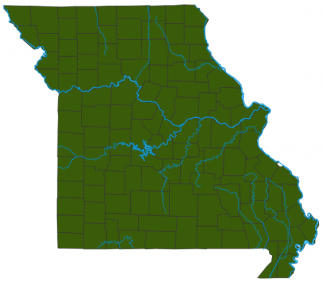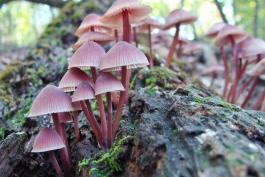
Small, with a bell-shaped, reddish brown cap; bleeds dark red when cut. Usually grows in clusters on decaying wood. June–September. Cap egg-shaped, becoming bell-shaped to conical, with a central knob and upturned margin; reddish pink when dry, becoming darker reddish brown when moist, and paler gray toward the lined margins; texture dry, becoming polished and radially lined; when cut, the flesh bleeds a dark, blood red liquid. Young specimens usually have a powdery bloom on the cap. Gills narrow to moderately broad; spacing close to nearly distant; whitish, staining a reddish brown; gills attached. Stalk skinny; pinkish to reddish tan; covered with fine hairs; longer, coarse hairs at the base; when young, the cut stalk bleeds dark red. Spore print white. Spores magnified are broadly elliptical, smooth, colorless. This little mushroom is easy to identify because of the bell-shaped cap and oozing, blood red liquid.
Lookalikes: Other Mycena species—none, however, “bleed” like this species.
Cap width: ½–2 inches; stalk length: 1–4 inches; stalk width: ⅟₃₂–⅛ inch.

Statewide.
Habitat and Conservation
Can grow singly, but is more often found in clusters on decaying wood.
Status
Not edible.
Life Cycle
Mushrooms exist most of the time underground or within rotting wood or leaf litter as a network of cells (mycelium) digesting and decomposing rotting material. When ready to reproduce, the mycelium sends up the mushroom, which is the reproductive structure. Spores are produced in the gills and are released to begin new mycelia elsewhere. The mycelium of a mushroom can live for decades.
Human Connections
Mushrooms decorate nature the way wildflowers do, adding to our pleasure on hikes. Like wildflowers, they are often bestowed with poetic or fanciful names, reflecting the amusement they bring to us. This mushroom is also sometimes called "bleeding fairy helmet."
Ecosystem Connections
This is one of the many fungus species that live on decaying wood. It and other such saprobic fungi play an important role in breaking down the staggering amount of biomass produced each year, returning nutrients to the soil—an unglamorous but vital role in the ecosystem.


Mushrooms are a lot like plants, but they lack chlorophyll and have to take nutrients from other materials. Mushrooms are neither plants nor animals. They are in a different kingdom — the fungi. Fungi include the familiar mushroom-forming species, plus the yeasts, molds, smuts, and rusts.
Always be cautious when eating edible mushrooms. Be absolutely sure of the ID, and only eat a small amount the first time you try it to avoid a reaction..





















